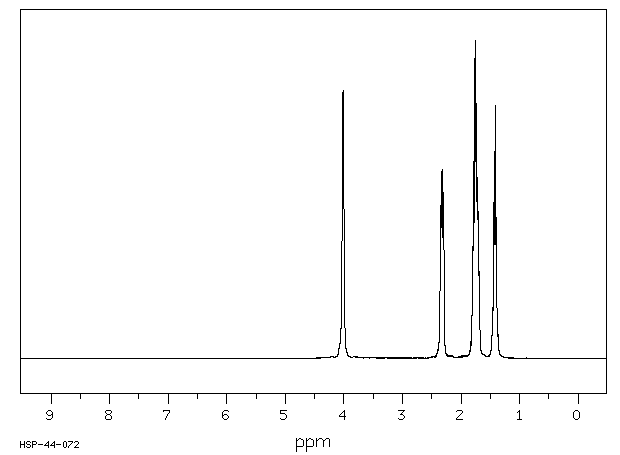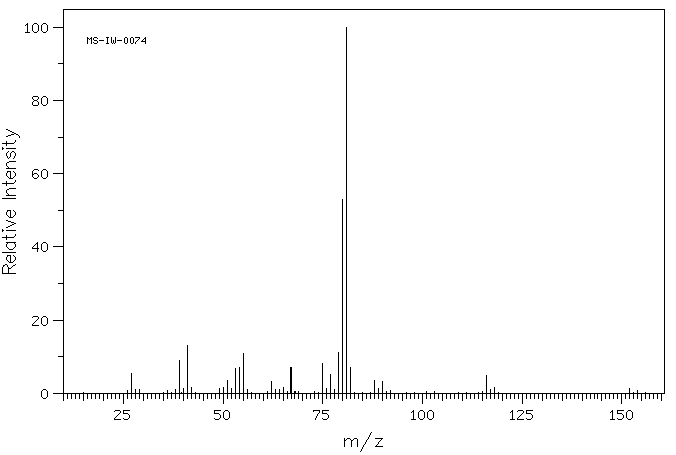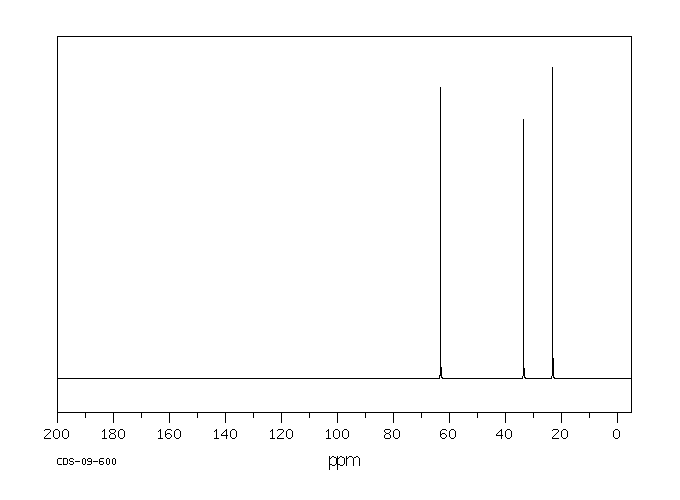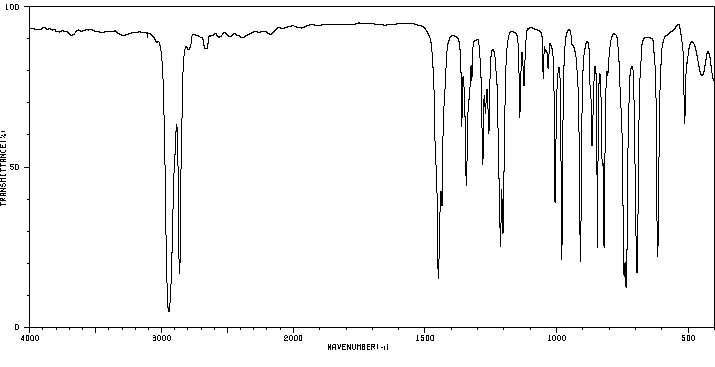1,2-二氯环己烷 | 1121-21-7
中文名称
1,2-二氯环己烷
中文别名
——
英文名称
1,2-dichlorocyclohexane
英文别名
——
CAS
1121-21-7
化学式
C6H10Cl2
mdl
MFCD00066857
分子量
153.051
InChiKey
GZEZIBFVJYNETN-UHFFFAOYSA-N
BEILSTEIN
——
EINECS
——
-
物化性质
-
计算性质
-
ADMET
-
安全信息
-
SDS
-
制备方法与用途
-
上下游信息
-
文献信息
-
表征谱图
-
同类化合物
-
相关功能分类
-
相关结构分类
物化性质
-
沸点:200.2 °C
-
熔点:-1.5 °C
-
保留指数:1416
计算性质
-
辛醇/水分配系数(LogP):3.2
-
重原子数:8
-
可旋转键数:0
-
环数:1.0
-
sp3杂化的碳原子比例:1.0
-
拓扑面积:0
-
氢给体数:0
-
氢受体数:0
安全信息
-
海关编码:2903890090
SDS
上下游信息
-
上游原料
中文名称 英文名称 CAS号 化学式 分子量 氯代环己烷 cyclohexyl chloride 542-18-7 C6H11Cl 118.606
反应信息
-
作为反应物:描述:1,2-二氯环己烷 在 1,1'-bis(trimethylsilyl)-1,1'-dihydro-4,4'-bipyridine 作用下, 以 乙腈 为溶剂, 反应 18.0h, 以51%的产率得到环己烯参考文献:名称:由1,1'-双(三甲基硅烷基)-1-邻二卤代化合物的脱卤ħ,1' ħ -4,4'- bipyridinylidene用于给出烯烃和炔烃在无盐的方式摘要:我们通过1,1'-双(三甲基硅烷基)-1-邻位报告二卤代化合物的过渡不含金属的脱卤ħ,1' ħ -4,4'- bipyridinylidene(1)在温和条件下,在三甲基甲硅烷其中卤化物和4,产生了4'-联吡啶作为副产物。该脱卤反应的合成方案对于各种二溴化合物作为底物均有效,同时保持了各种官能团的完整性。此外,邻二氯链烷和邻二溴链烯的还原也以无盐方式进行,得到相应的烯烃和炔。DOI:10.1039/c7cc07377a
-
作为产物:参考文献:名称:Markownikow, Justus Liebigs Annalen der Chemie, 1898, vol. 302, p. 20摘要:DOI:
文献信息
-
Highly selective halogenation of unactivated C(sp<sup>3</sup>)–H with NaX under co-catalysis of visible light and Ag@AgX作者:Shouxin Liu、Qi Zhang、Xia Tian、Shiming Fan、Jing Huang、Andrew WhitingDOI:10.1039/c8gc02628a日期:——The direct selective halogenation of unactivated C(sp3)–H bonds into C-halogen bonds was achieved using a nano Ag/AgCl catalyst at RT under visible light or LED irradiation in the presence of an aqueous solution of NaX/HX as a halide source, in air. The halogenation of hydrocarbons provided mono-halide substituted products with 95% selectivity and yields higher than 90%, with the chlorination of toluene
-
Photoreduction of Thioether Gold(III) Complexes: Mechanistic Insight and Homogeneous Catalysis作者:Zhen Cao、Dario M. Bassani、Brigitte BibalDOI:10.1002/chem.201804322日期:2018.12.12Complexes formed between AuCl3 and thioether ligands underwent a photoinduced reductive elimination under homogeneous conditions in dichloromethane and toluene solutions to afford the corresponding AuI complexes. All the gold(III) complexes were rapidly reduced to the gold(I) chloride complexes under 365 nm irradiation or ambient light while being thermally stable below 55 °C. The mechanism of photoreduction
-
[EN] ALBICIDIN DERIVATIVES, THEIR USE AND SYNTHESIS<br/>[FR] DÉRIVÉS D'ALBICIDINE, LEUR UTILISATION ET LEUR SYNTHÈSE申请人:TECH UNIVERSITÄT BERLIN公开号:WO2014125075A1公开(公告)日:2014-08-21The present invention relates to a antibiotically active compounds characterized by general formula (I), wherein X1, BB, BC, BD, BE and X2 are building blocks with D1, D2, D3, D4 or D5 being linkers which comprise carbon, sulphur, nitrogen, phosphor and/or oxygen atoms and which are covalently connecting the moities BA and BB, BB and BC, BC and BD, BD and BE and BE and BF, respectively, and wherein in particular the building block BC comprises an amino acid derivative. The invention relates further to said compounds for use in a method of treatment of diseases, in particular for use in a method of treatment of bacterial infections.
-
Method for producing organic compounds by substituting halogen atoms申请人:MITSUI CHEMICALS, INC.公开号:EP1486479A1公开(公告)日:2004-12-15The invention pertains to a method in which a halogen atom of an organic compound is replaced with a group derived from a nucleophilic agent, at high yield and high efficiency, by the following method which includes a step of reacting the nucleophilic agent with an organic material having a halogen atom bonded to a carbon atom having four σ bonds, more specifically: a method for producing an organic compound having Q, the method including a step of reacting a compound represented by general formula (2) with an organic starting material having at least one halogen atom bonded to a carbon atom having four σ bonds so as to replace the halogen atom in the organic starting material with Q: MQa (2) (wherein M represents an alkali metal atom, an alkali earth metal atom, or a rare earth metal atom; Q represents a moiety of an inorganic acid or an active hydrogen compound derived by eliminating a proton, wherein Q is a halogen atom different from the halogen atom in the organic starting material having the halogen atom bonded to the carbon atom having the four σ bonds; and a represents an integer of 1 to 3) in the presence of a compound represented by general formula (1) (wherein Z- represents an anion derived by eliminating a proton from an inorganic acid or an active hydrogen compound; R2 is the same or different; R2 each independently represent a C1-C10 hydrocarbon group or two R2 on the same nitrogen atom may be bonded with each other to form a ring with the nitrogen atom).这项发明涉及一种方法,其中有机化合物中的卤素原子被来自亲核试剂的基团取代,且产率高效率高,通过以下方法实现,包括以下步骤:将亲核试剂与具有与碳原子形成四个σ键的卤素原子相结合的有机材料反应的步骤,更具体地说:一种用于生产具有Q的有机化合物的方法,包括以下步骤:将由通式(2)表示的化合物与至少一个卤素原子与碳原子形成四个σ键的有机起始材料反应,以将有机起始材料中的卤素原子替换为Q: MQa (2) (其中M代表碱金属原子、碱土金属原子或稀土金属原子;Q代表由消除质子衍生的无机酸或活性氢化合物的基团,其中Q是不同于有机起始材料中卤素原子的卤素原子,该卤素原子与具有四个σ键的碳原子相结合;a表示1到3的整数),在通式(1)表示的化合物的存在下 (其中Z-代表由无机酸或活性氢化合物中消除质子衍生的阴离子;R2相同或不同;R2各自独立地表示C1-C10烃基,或者两个R2在同一氮原子上可能与彼此结合形成与氮原子的环)。
-
Oxidation of α,β-enones and alkenes with oxone and sodium halides: A convenient laboratory preparation of chlorine and bromine作者:R.Karl Dieter、Lois E. Nice、Sadanandan E. VeluDOI:10.1016/0040-4039(96)00295-x日期:1996.4Mixtures of oxone and sodium chloride or sodium bromide afford solutions of chlorine or bromine, respectively. These solutions effectively add chlorine and bromine to α,β-enones and alkenes. The method affords improved yields of 3-alkyl-2-halo-2-cycloalkenones which are sometimes difficult to prepare.
表征谱图
-
氢谱1HNMR
-
质谱MS
-
碳谱13CNMR
-
红外IR
-
拉曼Raman
-
峰位数据
-
峰位匹配
-
表征信息
同类化合物
顺式-2-氯环己基高氯酸盐
顺式-1-溴-2-氟-环己烷
顺式-1-叔丁基-4-氯环己烷
顺式-1,2-二氯环己烷
顺-1H,4H-十二氟环庚烷
镓,三(三氟甲基)-
镁二(1,1,2,2,3,3,4,4,5,5,6,6,7,7,8,8,8-十七氟-1-辛烷磺酸酯)
铵2,2,3,3,4,4,5,5,6,6,7,7,8,8,9,9,10,10,11,11,12,12,12-二十三氟十二烷酸盐
铜N-(2-氨基乙基)乙烷-1,2-二胺2-氰基胍二氯化盐酸
钾{[(十七氟辛基)磺酰基](甲基)氨基}乙酸酯
钠3-[(3-{[(十七氟辛基)磺酰基]氨基}丙基)(甲基)氨基]-1-丙烷磺酸酯
重氮基烯,(1-溴环己基)(1,1-二甲基乙基)-,1-氧化
辛酸,十五氟-,2-(1-羰基辛基)酰肼
赖氨酰-精氨酰-精氨酰-苯基丙氨酰-赖氨酰-赖氨酸
诱蝇羧酯B1
诱蝇羧酯
萘并[2,1-b]噻吩-1(2H)-酮
膦基硫杂酰胺,P,P-二(三氟甲基)-
脲,N-(4,5-二甲基-4H-吡唑-3-基)-
肼,(3-环戊基丙基)-,盐酸(1:1)
组织蛋白酶R
磷亚胺三氯化,(三氯甲基)-
碳标记全氟辛酸
碘甲烷与1-氮杂双环(4.2.0)辛烷高聚合物的化合物
碘甲烷-d2
碘甲烷-d1
碘甲烷-13C,d3
碘甲烷
碘环己烷
碘仿-d
碘仿
碘乙烷-D1
碘[三(三氟甲基)]锗烷
硫氰酸三氯甲基酯
甲烷,三氯氟-,水合物
甲次磺酰胺,N,N-二乙基-1,1,1-三氟-
甲次磺酰氯,氯二[(三氟甲基)硫代]-
甲基碘-12C
甲基溴-D1
甲基十一氟环己烷
甲基丙烯酸正乙基全氟辛烷磺
甲基三(三氟甲基)锗烷
甲基[二(三氟甲基)]磷烷
甲基1-氟环己甲酸酯
环戊-1-烯-1-基全氟丁烷-1-磺酸酯
环己烷甲酸4,4-二氟-1-羟基乙酯
环己烷,1-氟-2-碘-1-甲基-,(1R,2R)-rel-
环己基五氟丙烷酸酯
环己基(1-氟环己基)甲酮
烯丙基十七氟壬酸酯










